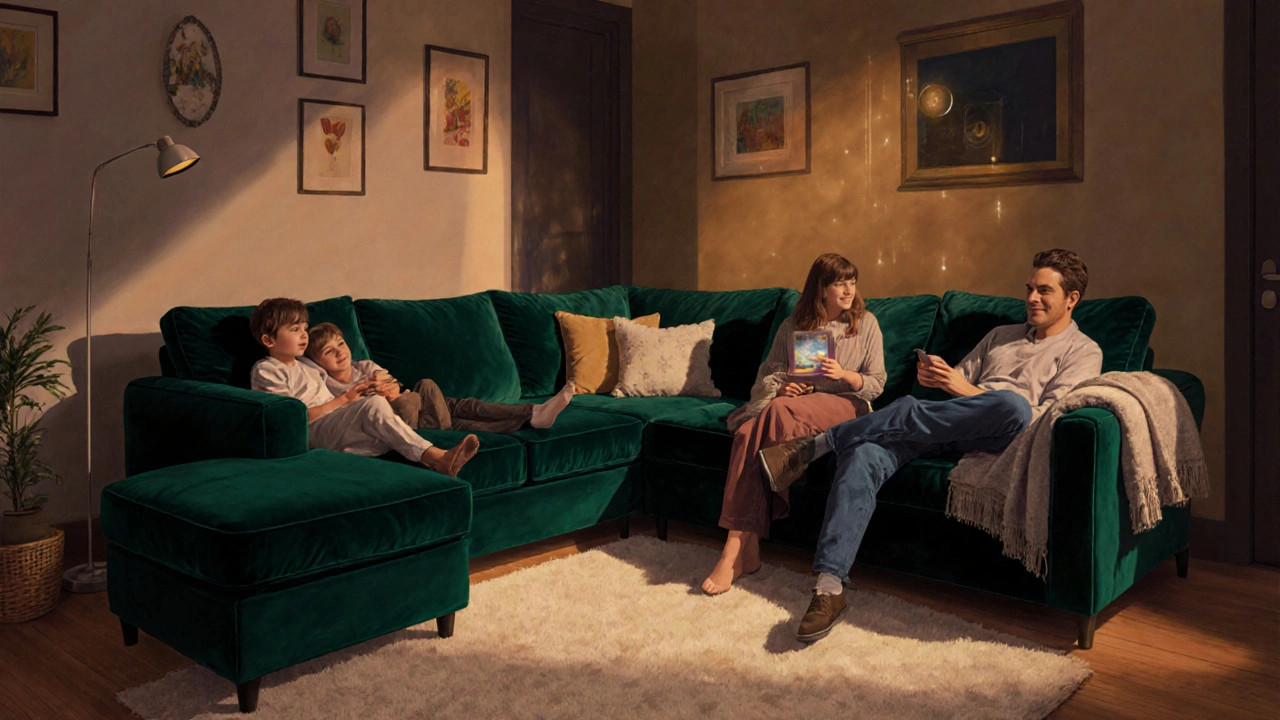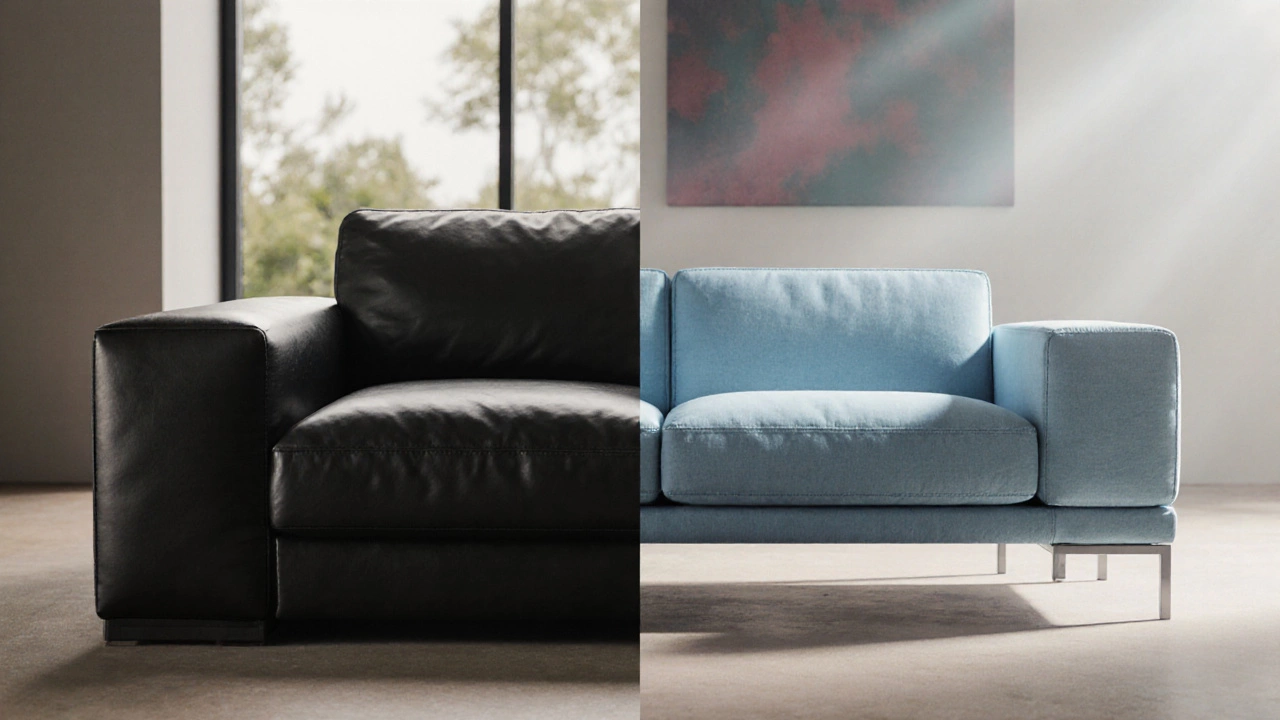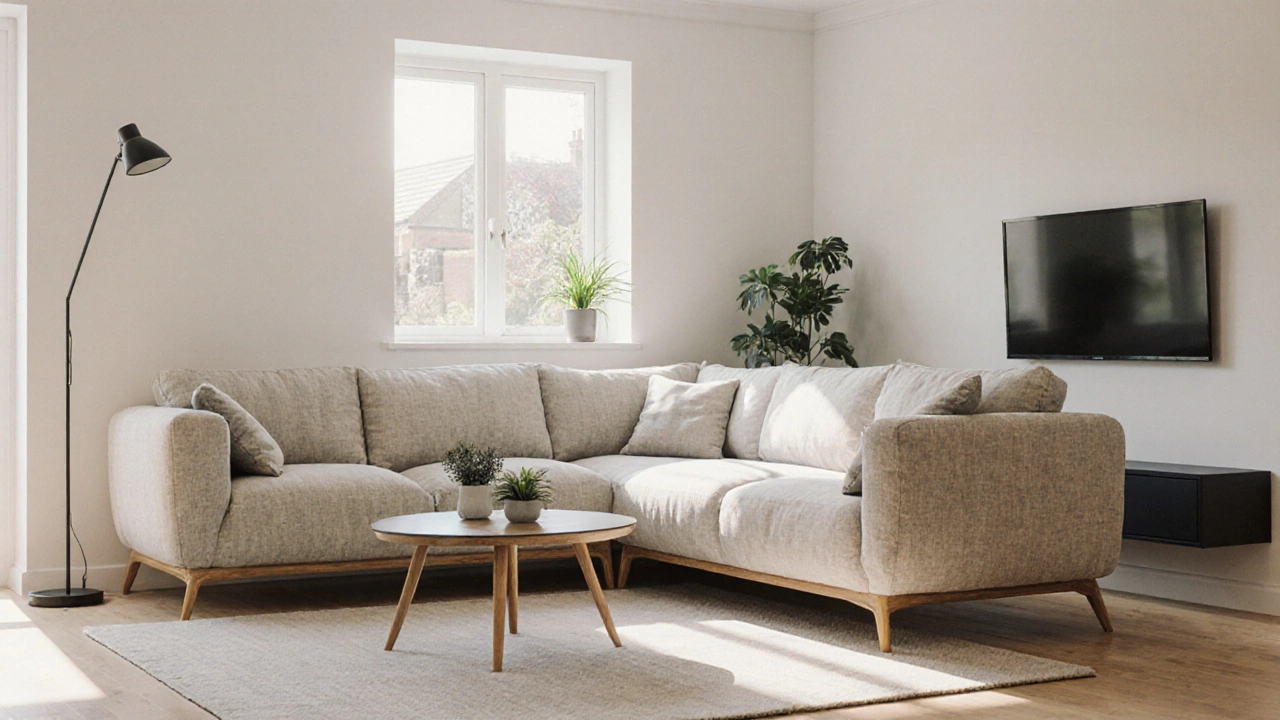Living Room Seating Space Calculator
Calculate Your Living Room Space
Determine which seating solution works best for your space based on the article's findings. Modern corner sofas can be highly space-efficient when selected correctly.
Corner sofas used to be the go-to choice for every living room in the 90s and early 2000s. Big, bulky, and often covered in fake leather, they dominated showrooms and TV interiors. But now, scrolling through Pinterest or Instagram, you might wonder: are corner sofas dated? The answer isn’t simple. They’re not out of style-they’ve just changed.
What made corner sofas popular in the first place
Corner sofas weren’t just about looks. They solved real problems. In smaller UK homes, especially in cities like Birmingham, space is tight. A corner sofa fits snugly into an L-shaped nook, freeing up floor space and creating a defined seating area without needing multiple chairs. They offered more seats than a standard three-seater, often with hidden storage underneath. For families, they were practical. For renters, they were a one-piece solution.
But their popularity came with a cost. Many older models were low to the ground, made from cheap materials, and had fixed shapes. You couldn’t rearrange them. You couldn’t move the chaise. They looked the same in every home-gray, beige, or brown, with thick, boxy arms. That’s where the ‘dated’ label stuck.
How corner sofas evolved
Today’s corner sofas don’t look like your mum’s 2003 model. The design shift started around 2018 and accelerated fast. Modern corner sofas are slimmer, lighter, and more modular. Brands like IKEA, Made.com, and even high-end designers like Sectional sofas are customizable seating systems designed to fit corner spaces, often with interchangeable pieces. Also known as modular sofas, they allow users to add or remove sections as needed. have pushed the trend forward.
Key changes:
- Low-profile frames: No more bulky arms. Today’s models sit closer to the floor with clean lines.
- Lighter fabrics: Linen, bouclé, and performance velvet replace stiff microfiber. You can actually see the weave now.
- Color variety: Not just beige. Deep emerald, charcoal, mustard, even pastel blues are common.
- Modular design: You can swap the chaise from left to right. Add an ottoman. Detach a section for a guest bed.
- Hidden storage: Still here, but smarter. Lift-up armrests, under-seat drawers, and zip-out cushions.
These aren’t just upgrades-they’re redefinitions. A modern corner sofa doesn’t dominate a room. It blends into it.
Why people still choose them in 2025
Let’s be honest: not every home is a Pinterest-perfect open-plan loft. Most UK homes still have awkward corners, narrow hallways, and limited square footage. Corner sofas still win in these spaces.
In Birmingham terraces, for example, a corner sofa can turn a tiny living room into a functional lounge without needing a second chair. Parents appreciate the extra seating for movie nights. Roommates like the ability to split the sofa into two zones-one for watching TV, one for reading.
Real-world example: A couple in Solihull bought a modular corner sofa last year. They started with just the base and right-side chaise. Six months later, they added a left-side chaise and a matching ottoman. Total cost: £1,200. They didn’t need to buy new furniture again. That’s longevity.
They’re also easier to move than multiple pieces. One delivery. One setup. No mismatched cushions or mismatched styles.

When corner sofas don’t work
They’re not for everyone. If your living room is wide and open-with a clear focal point like a fireplace or large window-a corner sofa can feel like a wall. It blocks sightlines. It makes the room feel closed off.
Also, if you love rearranging furniture often, a fixed corner unit might frustrate you. You can’t easily move it to the center of the room. You can’t turn it around. Some modular systems help, but they’re still anchored to the corner.
And if you’re going for a minimalist, Scandinavian look with lots of negative space, a large corner sofa might feel too heavy. In those cases, two sleek armchairs and a loveseat often read as more intentional.
Corner sofas vs. other seating options
Here’s how today’s corner sofas stack up against common alternatives:
| Feature | Corner Sofa | Sectional Sofa (non-corner) | Two Armchairs + Loveseat | Sofa Bed |
|---|---|---|---|---|
| Space efficiency | High-uses corner space | Moderate-needs open floor | Low-takes up more linear space | Moderate-dual function |
| Seating capacity | 4-6 people | 4-5 people | 3-4 people | 2-3 people (plus sleep) |
| Customization | High (modular models) | High | Medium | Low |
| Style flexibility | Medium to high | High | High | Low |
| Best for small rooms | Yes | No | No | Yes |
Corner sofas lead in space efficiency and seating capacity. If you need to seat a lot of people without crowding the room, they’re still the smartest choice.

How to pick a modern corner sofa
If you’re thinking of buying one, here’s what to look for:
- Go modular. Choose a system where pieces can be rearranged. Brands like H&M Home offers affordable, stylish modular sofas with interchangeable cushions and bases and BoConcept is a Danish brand known for sleek, customizable modular furniture make this easy.
- Check the frame. Solid wood or engineered wood is better than particleboard. Lift the sofa-if it feels light, it’s probably low quality.
- Test the depth. Too deep and you’ll sink in. Too shallow and it’s uncomfortable. Aim for 88-95cm depth for most adults.
- Look for removable covers. Spills happen. Machine-washable covers are a must.
- Don’t ignore the chaise. Is it wide enough? Can you stretch out? Some are too narrow to be useful.
And skip the fake leather. Real fabric-linen, cotton, or performance velvet-ages better and looks more expensive.
Final verdict: Are corner sofas dated?
No. But the ones you remember from 20 years ago? Those are.
Modern corner sofas are smarter, lighter, more stylish, and more adaptable than ever. They’re not a relic of the past-they’re a smart solution for today’s homes. If you’re renting, living in a smaller space, or just want maximum seating with minimal clutter, they’re still one of the best options out there.
The trick isn’t avoiding them. It’s choosing the right one. Skip the boxy, low-slung models. Go for clean lines, natural fabrics, and modularity. That’s how you make a corner sofa look current, not classic.
Are corner sofas still popular in the UK?
Yes, especially in cities like Birmingham, Manchester, and Leeds where homes are smaller. Modular corner sofas are now one of the top-selling sofa types in UK furniture stores, according to 2025 sales data from the British Furniture Confederation. They’re popular with renters, families, and people who want flexible seating without buying multiple pieces.
Can a corner sofa work in a large open-plan living room?
It can, but it needs to be the right kind. Avoid bulky, dark models. Go for a low-profile, light-colored modular corner sofa with open arms and slim legs. Position it to define a zone without blocking windows or views. Pair it with a floating TV unit and plenty of plants to keep the space feeling open.
Do corner sofas make a room look smaller?
Only if they’re the wrong style. Old, dark, low corner sofas can make a room feel boxed in. Modern versions with light fabrics, exposed legs, and clean lines actually make a room feel more spacious by maximizing seating without clutter. The key is proportion and color.
How long do corner sofas last?
A well-made modular corner sofa with a solid wood frame and removable covers can last 10-15 years. Cheaper ones with particleboard frames and glued-on covers may start to sag or fray in 3-5 years. Look for warranties of at least 5 years on the frame.
Are corner sofas better than sofa beds?
It depends on your needs. Corner sofas are better for daily comfort and seating capacity. Sofa beds are better if you need a guest bed regularly. Many people now choose a corner sofa with a separate pull-out ottoman or a hidden bed underneath-it gives you both without compromising on comfort.


Write a comment